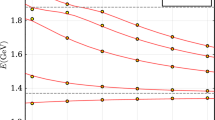Abstract.
Starting from the lowest-order chiral Lagrangian for the interaction of the baryon decuplet with the octet of pseudoscalar mesons we find an attractive interaction in the ΔK channel with L = 0 and I = 1, while the interaction is repulsive for I = 2. The attractive interaction leads to a pole in the second Riemann sheet of the complex plane and manifests itself in a large strength of the ΔK scattering amplitude close to the ΔK threshold, which is not the case for I = 2. However, we also make a study of uncertainties in the model and conclude that the existence of this pole depends sensitively upon the input used and can disappear within reasonable variations of the input parameters. We take advantage to study the stability of the other poles obtained for the \( {\frac{{3}}{{2}}}\)- dynamically generated resonances of the model and conclude that they are stable and not contingent to reasonable changes in the input of the theory.
Similar content being viewed by others
References
N. Kaiser, P.B. Siegel, W. Weise, Nucl. Phys. A 594, 325 (1995), arXiv:nucl-th/9505043.
E. Oset, A. Ramos, Nucl. Phys. A 635, 99 (1998), arXiv:nucl-th/9711022.
J.A. Oller, U.-G. Meißner, Phys. Lett. B 500, 263 (2001).
E. Oset, A. Ramos, C. Bennhold, Phys. Lett. B 527, 99 (2002)
C. Garcia-Recio, J. Nieves, E. Ruiz Arriola, M.J. Vicente Vacas, Phys. Rev. D 67, 076009 (2003), arXiv:hep-ph/0210311.
D. Jido, J.A. Oller, E. Oset, A. Ramos, U.G. Meißner, Nucl. Phys. A 725, 181 (2003), arXiv:nucl-th/0303062.
C. Garcia-Recio, M.F.M. Lutz, J. Nieves, Phys. Lett. B 582, 49 (2004), arXiv:nucl-th/0305100.
A. Dobado, J.R. Pelaez, Phys. Rev. D 56, 3057 (1997), arXiv:hep-ph/9604416.
J.A. Oller, E. Oset, J.R. Pelaez, Phys. Rev. D 59, 074001 (1999)
J. Gasser, H. Leutwyler, Nucl. Phys. B 250, 465 (1985).
G. Ecker, J. Gasser, A. Pich, E. de Rafael, Nucl. Phys. B 321, 311 (1989).
C.L. Schat, J.L. Goity, N.N. Scoccola, Phys. Rev. Lett. 88, 102002 (2002), arXiv:hep-ph/0111082.
J.A. Oller, E. Oset, Phys. Rev. D 60, 074023 (1999), arXiv:hep-ph/9809337.
J.R. Pelaez, Phys. Rev. Lett. 92, 102001 (2004), arXiv:hep-ph/0309292.
Particle Data Group Collaboration (S. Eidelman ), Phys. Lett. B 592, 1 (2004).
E.E. Kolomeitsev, M.F.M. Lutz, Phys. Lett. B 585, 243 (2004), arXiv:nucl-th/0305101.
LEPS Collaboration (T. Nakano ), Phys. Rev. Lett. 91, 012002 (2003), arXiv:hep-ex/0301020.
A. Hosaka, Phys. Lett. B 571, 55 (2003), arXiv:hep-ph/0307232.
R.L. Jaffe, F. Wilczek, Phys. Rev. Lett. 91, 232003 (2003), arXiv:hep-ph/0307341.
X.C. Song, S.L. Zhu, Mod. Phys. Lett. A 19, 2791 (2004), arXiv:hep-ph/0403093.
R. Bijker, M.M. Giannini, E. Santopinto, arXiv:hep-ph/0403029.
P. Bicudo, G.M. Marques, Phys. Rev. D 69, 011503 (2004), arXiv:hep-ph/0308073.
F.J. Llanes-Estrada, E. Oset, V. Mateu, arXiv:nucl-th/0311020.
E. Jenkins, A.V. Manohar, Phys. Lett. B 259, 353 (1991).
T.E.O. Ericson, W. Weise, Pions and Nuclei (Oxford Science Publications, 1988).
T.R. Hemmert, B.R. Holstein, J. Kambor, J. Phys. G 24, 1831 (1998), arXiv:hep-ph/9712496.
M.N. Butler, M.J. Savage, R.P. Springer, Nucl. Phys. B 399, 69 (1993), arXiv:hep-ph/9211247.
S. Sarkar, E. Oset, M.J. Vicente Vacas, Nucl. Phys. A 750, 294 (2005), arXiv:nucl-th/0407025.
Bologna-Glasgow-Rome-Trieste Collaboration (G. Giaco\-melli ), Nucl. Phys. B 111, 365 (1976).
J.S. Hyslop, R.A. Arndt, L.D. Roper, R.L. Workman, Phys. Rev. D 46, 961 (1992).
A.W. Thomas, K. Hicks, A. Hosaka, Prog. Theor. Phys. 111, 291 (2004), arXiv:hep-ph/0312083.
C. Hanhart , Phys. Lett. B 590, 39 (2004), arXiv:hep-ph/0312236.
T. Hyodo, A. Hosaka, E. Oset, Phys. Lett. B 579, 290 (2004), arXiv:nucl-th/0307105.
Author information
Authors and Affiliations
Additional information
U.-G. Meißner
Rights and permissions
About this article
Cite this article
Sarkar, S., Oset, E. & Vicente Vacas, M.J. Study of a possible S = + 1 dynamically generated baryonic resonance. Eur. Phys. J. A 24, 287–292 (2005). https://doi.org/10.1140/epja/i2005-10006-6
Received:
Accepted:
Published:
Issue Date:
DOI: https://doi.org/10.1140/epja/i2005-10006-6




